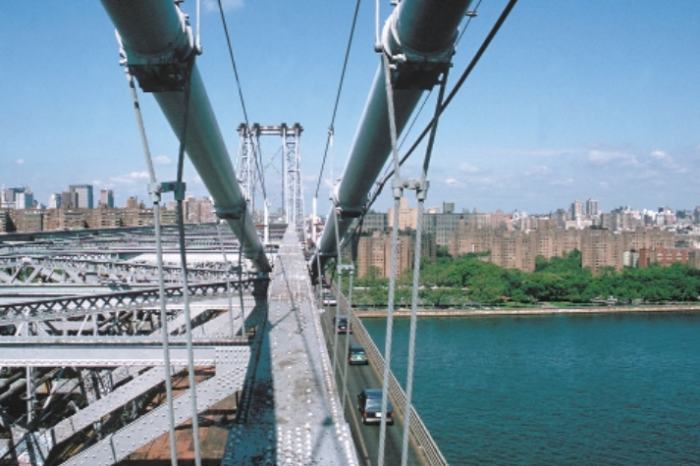
リーハイ大学の研究者は、50 年以上にわたり、橋梁、建物、その他の構造物の現場計測と試験の最前線に立ってきました。彼らは、高速道路や鉄道構造物の現場試験と評価に関する膨大なデータベースと豊富な経験を開発してきました。現場試験と評価は、構造研究の中でも特に難しい分野です。実際の負荷がかかった状態で構造物の実際の動作をリアルタイムで正確に評価できる唯一の方法です。現場測定は、実験室試験とコンピューター モデリングを実際の構造物の動作に結び付けて検証するリンクです。
構造挙動を正確に解釈するには正確なデータが必要であることはよく知られています。しかし、数百フィート上空の川の上空で風と寒さの中でデータを収集するのは、実験室で収集するよりもはるかに難しいことは明らかです。環境上の障害以外にも、測定値を正確に解釈する前に対処しなければならない変数が多数あります。したがって、データ収集システム、センサー、構造挙動を徹底的に理解することが不可欠です。最も重要なのは、このような悪条件下でも一貫して機能するデータ収集システムです。リーハイ大学の研究者は、Campbell Scientific CR9000 測定および制御システムが非常に堅牢で、最も過酷な現場環境にも耐えられることを発見しました。これらは、私たちのインフラストラクチャ監視プログラムの主力製品です。
最近完了した現場テスト プロジェクトの例には、現在大規模な改修工事が行われているニューヨーク市のウィリアムズバーグ橋の現場測定と長期リモート モニタリングが含まれます。このプロジェクトの大部分は、南と北の内側と外側の道路の両方にある既存のコンクリート充填グリッド デッキを鋼鉄直交異方性デッキに交換することです。包括的なラボ テスト プログラムに加えて、南の外側の道路では詳細な現場計測とテスト プログラムも実施されました。この研究は、現場での応力範囲を調査し、この複雑な構造システムの挙動とラボの応答との関係をより正確に特徴付けるために実施されました。データは CR9000 を使用して収集されました。制御された負荷テスト中、データは 82 個のひずみゲージから 200 Hz という高いサンプリング レートで収集されました。すべてのデータは、データロガーにインストールされた PCMCIA カードに一時的に保存されました。これらのデータは、その後、各テストの終了時に処理とバックアップのためにラップトップにコピーされました。コンパクトで頑丈な CR9000 は、テスト プログラム全体を通じて優れたパフォーマンスを発揮しました。データをリアルタイムで観察および確認できる機能は、テスト中に非常に役立ちました。
プログラムの 2 番目の部分は、約 7 か月のリモート モニタリングで構成されていました。データは、前述の CR9000 システムを使用して収集されました。プログラムのアップロードとデータのダウンロードは、リーハイ大学の大型構造システム向け先進技術 (ATLSS) の研究者によって特別に構成された 2 つのモデムを使用して実行されました。1 つのモデムは現場に設置され、もう 1 つは ATLSS 研究所のオフィスに設置されました。データは 1 ~ 14 日ごとにデスクトップ PC にダウンロードされました。データ収集システム全体は、床梁 64E の西面にボルトで固定されたスチール製の箱に保管されました。
構造物へのアクセスは非常に困難でした。交通量が多く、ロガーが遠隔地にあるため、監視プログラムには特別な問題がありました。便利で定期的なアクセスは不可能でした。CR9000 により、リーハイ大学の研究者は遠隔地から大量のデータを収集できるようになり、橋自体に何度も足を運ぶ必要がなくなりました。
収集されるデータの量を最小限に抑えるため、時間履歴は連続的に記録されませんでした。代わりに、CR9000 は、活荷重によって誘発される応力が所定のトリガーを超えたときに記録を開始するようにプログラムされました。トリガーの適切な大きさは、制御された荷重テストから事前に決定されました。
たとえば、大型トラックが特定の場所で 6.0 ksi のピーク応力を発生することが観測されたとします。これらのゲージのソフトウェア トリガーは 5.9 ksi に設定されました。応力がその値を超えると、時間履歴が記録されました。トリガー イベント前のデータも、指定された時間 (たとえば 5 秒間) 記録されました (つまり、5 秒のバッファーが維持されました)。CR9000 は、指定された時間 (この場合も 5 秒間) 記録を続け、その後記録を停止しました。トリガーされた時間履歴として監視されたこれらのチャネルは、デジタル バランス アルゴリズムを使用して、1 時間ごとおよび 30 分ごとに自動的にゼロ再設定されました。バッファーの適切な長さと合計記録時間は、現場で決定されました。この手法により、十分な時間依存データと、高応力範囲イベントの検証方法が提供され、応力範囲ヒストグラムからスプリアス信号が除外されることが保証されました。
応力範囲ヒストグラムは、CR9000 の命令セットに含まれるレインフローサイクルカウント法を使用して作成されました。応力範囲ヒストグラムは継続的に生成され、トリガーで動作しないため、すべてのサイクルがカウントされます。さらに、ヒストグラムは 10 分ごとに更新されます。したがって、停電が発生した場合でも、失われるデータは最小限です。応力範囲ビンは 0.5 ksi 間隔に分割されました。研究の結果は、AASHTO LRFD 橋梁設計仕様に組み込まれます。